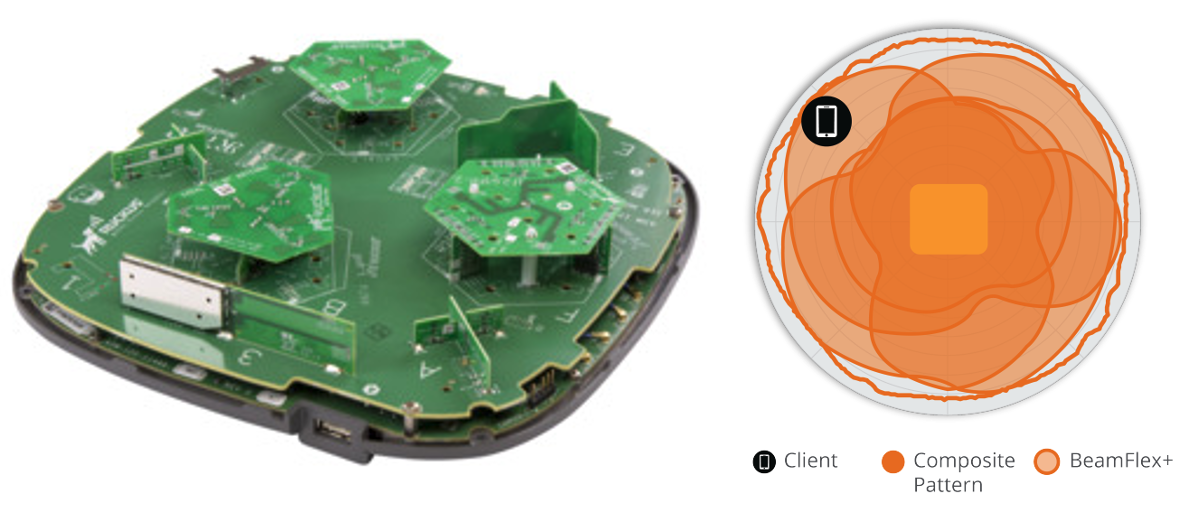Bienvenue chez RUCKUS Networks, qui fait partie du portefeuille mondial de solutions réseau de CommScope. En savoir plus.
In this blog post, we will delve into the details of the RUCKUS R770 access point with Wi-Fi 7 technology, exploring its specifications, security enhancements, wider channels, and the revolutionary features that come with Wi-Fi 7. You can catch the full RUCKCast® interview at the following links, depending on your podcast app (Apple podcast, Spotify, Google podcast, Amazon Music).
What are Wi-Fi 7 Access Point's specifications?
Tuofu Lu, the product manager of the RUCKUS R770 Wi-Fi 7 access point, provided insights into the specifications of this product based on the new standard, Wi-Fi 7. The R770 is a tri-band access point, operating at 2.4 GHz, 5 GHz, and the newly introduced 6 GHz frequency simultaneously. It maintains full backward compatibility with Wi-Fi 6E while supporting the new Wi-Fi 7 standard across all three frequency bands, resulting in a maximum physical data rate of a staggering 12 Gbps.

For regions where 6 GHz bands are not yet supported, the R770 offers a software-controlled, dual-band configuration that can reach a maximum physical data rate of 6.5 Gbps. The RF configuration includes 2x2 in 2.4 GHz, 4x4 in 5 GHz, and 2x2 in the 6 GHz band for the tri-band setup. In the dual-band configuration, it supports 2x2 in 2.4 GHz and 4x4 in 5 GHz.
RUCKUS has retained its proprietary performance features in technologies such as BeamFlex+®, PD-MRC, ChannelFly®, and SmartMesh™ in the R770. Furthermore, the device offers support for both low-power indoor and standard power with AFC (Automated Frequency Control) for the 6 GHz band, along with a proprietary indoor location scheme to facilitate AFC operation.
In terms of connectivity, the R770 boasts a 10 Gbps Ethernet backhaul and a 1 Gbps auxiliary port. It supports Power over Ethernet (PoE) on the 10 Gbps Ethernet port, compliant with 802.3bt Class 5 standards, as well as a 48-volt external DC power supply. Additionally, the R770 Wi-Fi 7 access point features an IoT (Internet of Things) radio that can support BLE (Bluetooth® Low Energy) or Zigbee®, offering programmability and Matter and Thread capabilities. An added USB port is available to support additional IoT radios.
What Enhanced Wireless Security Features are in the RUCKUS R770?
One of the standout features of the RUCKUS R770 Wi-Fi 7 access point is its security enhancements, both from the IEEE standard for Wi-Fi 7 and additional functionality from RUCKUS. With support for TPM (Trusted Platform Module) 2.0, the R770 offers advanced encryption capabilities, including the storage of longer encryption keys. This improvement provides heightened security, making it more challenging for potential threats to compromise the system.
A new addition to the R770's security features is "secure boot." Secure boot is intended to safeguard the booting software from potential tampering by hackers, reducing the risk that malware cannot execute within the system. Additionally, the R770 introduces DPSK3 (Dynamic Pre-Shared Key 3), combining traditional DPSK™ with WPA3 encryption, enhancing security across all three frequency bands. For government and security-conscious users, FIPS 140-3 compliance is also supported.
Operating Environment and Management
The RUCKUS R770 Wi-Fi 7 access point demonstrates versatility in its operating environment, with a temperature range of -10 to 50 degrees Celsius. This extended temperature range sets it apart from many others available on the market, which typically support temperatures between 0 to 40 degrees Celsius.
On the management side, the R770 is compatible with RUCKUS SmartZone 7.0 and RUCKUS One™, offering diverse options for network management and control. It also supports the RUCKUS Unleashed™ management platform, providing flexibility to users in managing their networks.
What are Wi-Fi 7 benefits: The Road Ahead with Wi-Fi 7?
The RUCKUS R770's announcement heralds a new era in wireless networking with Wi-Fi 7. Wi-Fi 7 is not merely an incremental improvement; it brings forth several groundbreaking features that promise to enhance the user experience across various industries /verticals.
What are the Wi-Fi 7 features regarding QAM, throughput, GHz bandwidth, MLO, interference, and latency?
- Speed and Throughput: Wi-Fi 7 continues the tradition of improving speed and throughput with an increased bandwidth in the 6 GHz band and the introduction of 4K-QAM (quadrature amplitude modulation). These enhancements, such as 4K-QAM, result in significantly higher data rates, with max PHY data rates of up to 19 Gbps for compatible devices as well as greater channel width (up to 320 Mhz), faster speeds, and higher throughput.
- Punctured Transmission (also known as preamble puncturing): Punctured transmission is a novel feature that allows devices to transmit data even in the presence of interference, a marked improvement from previous standards. This improvement in spectrum utilization ensures a more efficient and reliable connection, especially in crowded environments.
- Multi-Link Operation (MLO): Wi-Fi 7 introduces Multi-Link Operation, enabling devices to utilize two frequency links across different bands simultaneously. This not only boosts throughput but also significantly reduces latency. Reduced latency for network traffic is particularly crucial to driving better performance for applications like gaming, video conferencing, and augmented (AR) or virtual reality (VR) experiences.
- QoS Improvement: Wi-Fi 7 incorporates numerous Quality of Service (QoS) enhancements learned from Wi-Fi 6 deployments to deliver an overall improved user experience and help to improve peak performance.
Target Verticals for Ruckus R770
The RUCKUS R770 and Wi-Fi 7 are poised to make a significant impact across various industries and verticals. Some of the sectors where this technology is expected to shine include:
- Hospitality: Wi-Fi 7's low latency and reliability can elevate the guest experience in hotels, supporting business professionals' work needs and providing leisure guests with high-quality Wifi streaming and online content access.
- Education: Wi-Fi 7 can enable seamless, supported learning environments in educational institutions, facilitating video streaming, collaboration on shared documents, and online classes.
- Large Public Venues: Airports, convention centers, stadiums, and arenas will benefit from enhanced capacity, enabling users to stream events, order concessions, potentially driving immersive consumer experiences, and improving operational efficiency through data insights.
- Multi-Dwelling Units (MDUs): MDUs such as apartment complexes can benefit from reduced interference, decreased congestion, and improved gaming experiences. Remote workers will have reliable video conferencing capabilities and better connectivity for various applications.
Conclusion
In conclusion, the introduction of the RUCKUS R770 Wi-Fi 7 Access Point and Wi-Fi 7 represents a pivotal moment in wireless networking. With impressive specifications, enhanced security features, and groundbreaking Wi-Fi 7 capabilities, the R770 promises to revolutionize connectivity in diverse industries. As the Wi-Fi ecosystem evolves, RUCKUS Networks has made extensive efforts to drive interoperability with a wide range of client devices, providing a seamless transition to the future of wireless connectivity. For more information and technical details, visit the RUCKUS Networks website and explore the Wi-Fi 7 page. The future of Wi-Fi is here, and it's faster, more efficient, and more secure than ever before.
FAQ
Can a Wi-Fi 7 access point be used in conjunction with other access points?
Yes, a Wi-Fi 7 AP can be used in conjunction with other types of APs. Wi-Fi 7, technically known as 802.11be, is the next generation of Wi-Fi technology that offers faster speeds and increased capacity compared to previous versions. While it may be compatible with older APs, it is important to note that the overall performance of the Wi-Fi 7 AP might be limited by the capabilities of any surrounding APs and clients in the network. Therefore, it is typically recommended to use Wi-Fi 7 APs in a network with other Wi-Fi 7 APs to fully leverage the benefits of the technology. However, interoperability between different generations of Wi-Fi devices is generally supported, allowing for seamless connectivity and coverage across other APs within a network.
How can I learn more about Wi-Fi 7 and RUCKUS?
RUCKUS Networks has captured content ranging from a Wi-Fi 7 access point overview to detailed descriptions of capabilities, products, and user studies on its Wi-Fi 7-focused web page.
Get ahead with RUCKUS Networks!
Sign up for exclusive insights from RUCKUS Networks.














